Approaches for Hybrid Scaling of Agile in the IT Industry: A Systematic Literature Review and Research Agenda
Abstract
:1. Introduction
2. Research Methodology
2.1. Methods
2.2. Phases and Quality Assessment
2.3. Inclusion and Exclusion Criteria
2.4. Databases and Search Strategy
2.5. Research Questions
- RQ1. What is the distribution of studies over the last decade?
- RQ2. Which journals have published these studies?
- RQ3. What level of association can be established between these journals?
- RQ4. Which research methodologies predominate?
- RQ5. What network of connections is established between the key terms of the studies?
- RQ6. Which clusters are identified among these key terms?
- RQ7. Which are the different hybrid approaches identified in published studies to scale agile?
3. Results
3.1. RQ1: What Is the Distribution of Studies over the Last Decade?
3.2. RQ2: Which Journals Have Published These Studies?
3.3. RQ3: What Level of Association Can Be Established between These Journals?
3.4. RQ4: Which Research Methodologies Predominate?
3.5. RQ5: What Network of Connections Is Established between the Key Terms of the Studies?
3.6. RQ6: Which Clusters Are Identified among These Key Terms?
3.7. RQ7: Which Are the Different Hybrid Approaches Identified in Published Studies to Scale Agile?
4. Discussion
5. Research Agenda
6. Conclusions
Author Contributions
Funding
Institutional Review Board Statement
Informed Consent Statement
Data Availability Statement
Conflicts of Interest
Appendix A
| ID | Document | Year | DOI |
|---|---|---|---|
| S1 | Applying standard independent verification and validation techniques within an agile framework: Identifying and reconciling incompatibilities | 2019 | 10.1002/sys.21487 |
| S2 | Scaling for agility: A reference model for hybrid traditional-agile software development methodologies | 2018 | 10.1007/s10796-016-9672-8 |
| S3 | Coordination Challenges in Large-Scale Software Development: A Case Study of Planning Misalignment in Hybrid Settings | 2018 | 10.1109/TSE.2017.2730870 |
| S4 | SAM: Preliminary Hybrid Model to Support Agile Large-Scale Transformation in Software Industries | 2020 | 10.19053/01211129.v29.n54.2020.11763 |
| S5 | Managing the Hybrid Organization: How Can Agile and Traditional Project Management Coexist? | 2021 | 10.1080/08956308.2021.1843331 |
| S6 | Scalable Agile Frameworks in Large Enterprise Project Portfolio Management | 2023 | 10.1109/ACCESS.2023.3312728 |
| S7 | A framework for modeling structural association among De-motivators of scaling agile | 2021 | 10.1002/smr.2366 |
| S8 | Remote agile: Problems, solutions, and pitfalls to avoid | 2023 | 10.1016/j.bushor.2022.10.003 |
| S9 | What Makes Agile Software Development Agile? | 2022 | 10.1109/TSE.2021.3099532 |
| S10 | Large scale quality transformation in hybrid development organizations—A case study | 2021 | 10.1016/j.jss.2020.110836 |
| S11 | Towards the statistical construction of hybrid development methods | 2021 | 10.1002/smr.2315 |
| S12 | Agile, Traditional, and Hybrid Approaches to Project Success: Is Hybrid a Poor Second Choice? | 2021 | 10.1177/8756972820973082 |
| S13 | Issues and challenges impacting the successful management of agile-hybrid projects: A grounded theory approach | 2021 | 10.1016/j.ijproman.2021.03.002 |
| S14 | Designing an Agile, flexible and resilient disaster supply chain network using a hybrid group decision-making robust optimization framework | 2023 | 10.1016/j.cie.2023.109591 |
| S15 | Quality culture boosts agile transformation—Action research in a business-to-business software business | 2023 | 10.1002/smr.2504 |
| S16 | The nexus of project management approaches in sustainable development: innovative behaviors as a mechanism in the Polish financial industry | 2024 | 10.1108/IJMPB-09-2023-0219 |
| S17 | Characteristics of self-managing teams in rapid product development projects | 2018 | 10.1504/IJVCM.2018.091097 |
| S18 | Providing a model of LeAgile hybrid paradigm practices and its impact on supply chain performance | 2022 | 10.1108/IJLSS-04-2021-0073 |
| S19 | An Orchestration Framework for Digital Innovation: Lessons From the Healthcare Industry | 2023 | 10.1109/TEM.2022.3167259 |
| S20 | From transformation to normalization: An exploratory study of a large-scale agile transformation | 2023 | 10.1177/02683962231164428 |
| S21 | Job-work fit as a determinant of the acceptance of large-scale agile methodology | 2020 | 10.1016/j.jss.2020.110577 |
| S22 | Large-Scale Agile Project Management in Safety-Critical Industries: A Case Study on Challenges and Solutions | 2024 | 10.1080/10580530.2024.2349886 |
| S23 | Reporting in large-scale agile organizations: insights and recommendations from a case study in software development | 2023 | 10.1007/s10257-023-00643-1 |
| S24 | Estimation of software quality parameters for hybrid agile process model | 2021 | 10.1007/s42452-021-04305-0 |
| S25 | Expert Survey on Current Trends in Agile, Disciplined and Hybrid Practices for Software Development | 2021 | 10.2478/acss-2021-0005 |
| S26 | Hybrid Project Management between Traditional Software Development Lifecycle and Agile Based Product Development for Future Sustainability | 2023 | 10.3390/su15021121 |
| S27 | Structured software development versus agile software development: a comparative analysis | 2023 | 10.1007/s13198-023-01958-5 |
| S28 | Dysfunctional Agile–Stage-Gate Hybrid Development: Keeping Up Appearances | 2022 | 10.1142/S0219877022400041 |
| S29 | MFPP: Matrix-based flexible project planning | 2022 | 10.1016/j.softx.2022.100973 |
| S30 | The impact of tailoring criteria on agile practices adoption: A survey with novice agile practitioners in Brazil | 2018 | 10.1016/j.jss.2017.12.012 |
| S31 | Goals and challenges in hybrid software development approaches | 2021 | 10.1002/smr.2382 |
| S32 | XPS-MoSCoW: A Prioritization-Based Hybrid Agile Model of SCRUM and Extreme Programming | 2022 | 10.4018/IJSI.297989 |
| S33 | Agile-Concurrent hybrid: A framework for concurrent product development using Scrum | 2020 | 10.1177/1063293X20958541 |
| S34 | Agile–Stage-Gate for Manufacturers | 2018 | 10.1080/08956308.2018.1421380 |
| S35 | Enhancing Hybrid OSS Development Through Agile Methods and High Media Synchronicity | 2021 | 10.1145/3508484.3508490 |
| S36 | Agile Software Development and Reuse Approach with Scrum and Software Product Line Engineering | 2023 | 10.3390/electronics12153291 |
| S37 | Recommendation of Project Management Practices: A Contribution to Hybrid Models | 2022 | 10.1109/TEM.2021.3101179 |
| S38 | The Role and Characteristics of Hybrid Approaches to Project Management in the Development of Technology-Based Products and Services | 2021 | 10.1177/8756972820956884 |
References
- Hron, M.; Obwegeser, N. Why and how is Scrum being adapted in practice: A systematic review. J. Syst. Softw. 2022, 183, 111110. [Google Scholar] [CrossRef]
- Martins, P.V.; Zacarias, M. An Agile Business Process Improvement Methodology. Procedia Comput. Sci. 2017, 121, 129–136. [Google Scholar] [CrossRef]
- Usländer, T. Agile Service Engineering in the Industrial Internet of Things. Future Internet 2018, 10, 100. [Google Scholar] [CrossRef]
- Cividino, S.; Egidi, G.; Zambon, I.; Colantoni, A. Evaluating the Degree of Uncertainty of Research Activities in Industry 4.0. Future Internet 2019, 11, 195. [Google Scholar] [CrossRef]
- Pauser, M. Agile Organizational Concepts for Retail Companies in Times of Digitalization: Design and Management of Agile Organizational Structures for More Competitiveness in the Face of Changing Customer Needs. In Multisensory in Stationary Retail: Principles and Practice of Customer-Centered Store Design; Mau, G., Schweizer, M., Oriet, C., Eds.; Springer Fachmedien Wiesbaden: Wiesbaden, Germany, 2023; pp. 399–421. [Google Scholar] [CrossRef]
- Ali, I. Doing the Organizational Tango: Symbiotic Relationship between Formal and Informal Organizational Structures for an Agile Organization. Interdiscip. J. Inf. Knowl. Manag. 2016, 11, 55–72. [Google Scholar] [CrossRef]
- Marnewick, C.; Marnewick, A.L. Benefits realisation in an agile environment. Int. J. Proj. Manag. 2022, 40, 454–465. [Google Scholar] [CrossRef]
- Project Management Institute. Agile Practice Handbook; Project Management Institute: Newton Square, PA, USA, 2017. [Google Scholar]
- Dong, H.; Dacre, N.; Ceylan, S. What is Agile Project Management? Developing a New Definition Following a Systematic Literature Review. Proj. Manag. J. 2024, in press. [CrossRef]
- Abbas, J. Quintessence of Traditional and Agile Requirement Engineering. J. Softw. Eng. Appl. 2016, 9, 63–70. [Google Scholar] [CrossRef]
- Wysocki, R.K. Effective Project Management: Traditional, Agile, Extreme, Hybrid, 8th ed.; John Wiley & Sons: Indianapolis, IN, USA, 2019. [Google Scholar]
- Royce, W.W. Managing the Development of Large Software Systems. Proc. IEEE WESCON 1970, 26, 328–388. [Google Scholar]
- Parsons, D.; Ramesh, L.; Lange, M. Test Driven Development: Advancing Knowledge by Conjecture and Confirmation. Future Internet 2021, 3, 281–297. [Google Scholar] [CrossRef]
- Mugridge, R.; Utting, M.; Streader, D. Evolving Web-Based Test Automation into Agile Business Specifications. Future Internet 2011, 3, 159–174. [Google Scholar] [CrossRef]
- Answer, F.; Aftad, S.; Shah, S.S.M.; Waheed, U. Comparative Analysis of Two Popular Agile Process Models: Extreme Programming and Scrum. Int. J. Comput. Sci. Telecommun. 2019, 8, 1–7. [Google Scholar]
- Kapitsaki, G.M.; Christou, M. Where is Scrum in the current Agile world? In Proceedings of the 2014 9th International Conference on Evaluation of Novel Approaches to Software Engineering (ENASE), Lisbon, Portugal, 28–30 April 2014.
- Blaskovics, B.; Czifra, J.; Klimkó, G.; Szontágh, P. Impact of the Applied Project Management Methodology on the Perceived Level of Creativity. Acta Polytech. Hung. 2023, 20, 101–120. [Google Scholar] [CrossRef]
- Nozari, H.; Ghahremani-Nahr, J. The Impact Of Blockchain Technology And The Internet Of Things On The Agile And Sustainable Supply Chain. Int. J. Innov. Eng. 2022, 2, 33–41. [Google Scholar] [CrossRef]
- El Khatib, M.; Al Hosani, A.; Al Hosani, I.; Albuflasa, K. Agile Project Management and Project Risks Improvements: Pros and Cons. Mod. Econ. 2022, 13, 1157–1176. [Google Scholar] [CrossRef]
- Wafa, R.; Khan, M.Q.; Malik, F.; Abdusalomov, A.B.; Cho, Y.I.; Odarchenko, R. The Impact of Agile Methodology on Project Success, with a Moderating Role of Person’s Job Fit in the IT Industry of Pakistan. Appl. Sci. 2022, 12, 10698. [Google Scholar] [CrossRef]
- Trzeciak, M. Sustainable Risk Management in IT Enterprises. Risks 2021, 9, 135. [Google Scholar] [CrossRef]
- Weichbroth, P. A Case Study on Implementing Agile Techniques and Practices: Rationale, Benefits, Barriers and Business Implications for Hardware Development. Appl. Sci. 2022, 12, 8457. [Google Scholar] [CrossRef]
- Valdés-Rodríguez, Y.; Hochstetter-Diez, J.; Díaz-Arancibia, J.; Cadena-Martínez, R. Towards the Integration of Security Practices in Agile Software Development: A Systematic Mapping Review. Appl. Sci. 2023, 13, 4578. [Google Scholar] [CrossRef]
- Salin, H.; Lundgren, M. Towards Agile Cybersecurity Risk Management for Autonomous Software Engineering Teams. J. Cybersecur. Priv. 2022, 2, 276–291. [Google Scholar] [CrossRef]
- Project Management Institute. Project Management Body of Knowledge, 7th ed.; Project Management Institute: Newton Square, PA, USA, 2021. [Google Scholar]
- Sithambaram, J.; Nasir, M.H.N.B.M.; Ahmad, R. Issues and challenges impacting the successful management of agile-hybrid projects: A grounded theory approach. Int. J. Proj. Manag. 2021, 39, 474–495. [Google Scholar] [CrossRef]
- Sońta-Drączkowska, E.; Krogulec, A. Challenges of scaling agile in large enterprises and implications for project management. Int. J. Manag. Proj. Bus. 2024, 17, 360–384. [Google Scholar] [CrossRef]
- Almeida, F.; Simões, J.; Lopes, S. Exploring the Benefits of Combining DevOps and Agile. Future Internet 2022, 14, 63. [Google Scholar] [CrossRef]
- Kadenic, M.D.; Tambo, T. Reinstitutionalization of project management offices by large-scale agile frameworks. J. Mod. Proj. Manag. 2021, 9, 87–101. [Google Scholar]
- Ebert, C.; Paasivaara, M. Scaling Agile. IEEE Softw. 2017, 34, 98–103. [Google Scholar] [CrossRef]
- Uludağ, O.; Philipp, P.; Putta, A.; Paasivaara, M.; Lassenius, C.; Matthes, F. Revealing the state of the art of large-scale agile development research: A systematic mapping study. J. Syst. Softw. 2022, 194, 111473. [Google Scholar] [CrossRef]
- Pavlíčková, M.; Mojžišová, A.; Bodíková, Z.; Szeplaki, R.; Laciak, M. Integration and Implementation of Scaled Agile Framework and V-Model in the Healthcare Sector Organization. Electronics 2024, 13, 2051. [Google Scholar] [CrossRef]
- Verwijs, C.; Russo, D. A theory of scrum team effectiveness. ACM Trans. Softw. Eng. Methodol. 2023, 32, 1–51. [Google Scholar] [CrossRef]
- Block, S. Large-Scale Agile Frameworks, 1st ed.; Springer: Berlin/Heidelberg, Germany, 2023. [Google Scholar]
- Digital.ai. 17th State of Agile Report. 2023. Available online: https://digital.ai/resource-center/analyst-reports/state-of-agile-report/ (accessed on 2 September 2024).
- Almeida, F.; Espinheira, E. Large-Scale Agile Frameworks: A Comparative Review. J. Appl. Sci. Manag. Eng. Technol. 2021, 2, 16–29. [Google Scholar] [CrossRef]
- Behrens, A.; Ofori, M.; Noteboom, C.; Bishop, D. A systematic literature review: How agile is agile project management? Issues Inf. Syst. 2021, 22, 278–295. [Google Scholar] [CrossRef]
- Dikert, K.; Paasivaara, M.; Lassenius, C. Challenges and success factors for large-scale agile transformations: A systematic literature review. J. Syst. Softw. 2016, 119, 87–108. [Google Scholar] [CrossRef]
- Edison, H.; Wang, X.; Conboy, K. Comparing Methods for Large-Scale Agile Software Development: A Systematic Literature Review. IEEE Trans. Softw. Eng. 2022, 48, 2709–2731. [Google Scholar] [CrossRef]
- Project Management Institute. Pulse of Profession. 2021. Available online: https://www.pmi.org/learning/thought-leadership/pulse/pulse-of-the-profession-2021 (accessed on 2 August 2024).
- Vacari, I.; Priklandnicki, R. Adopting Agile Methods in the Public Sector: A Systematic Literature Review. In Proceedings of the 27th International Conference on Software Engineering and Knowledge Engineering, Pittsburgh, PA, USA, 6–8 July 2015. [Google Scholar]
- Kasauli, R.; Knauss, E.; Horkoff, J.; Liebel, G.; Oliveira Neto, F.G. Requirements engineering challenges and practices in large-scale agile system development. J. Syst. Softw. 2021, 172, 110851. [Google Scholar] [CrossRef]
- Carroll, N.; Conboy, K.; Wang, X. From transformation to ormalization: An exploratory study of a large-scale agile transformation. J. Inf. Technol. 2023, 38, 267–303. [Google Scholar] [CrossRef]
- Mirzaei, M.; Mabin, V.J.; Zwikael, O. Customising Hybrid project management methodologies. Prod. Plan. Control 2024, in press. [CrossRef]
- Kolaski, K.; Logan, L.R.; Ioannidis, J. Guidance to best tools and practices for systematic reviews. Syst. Rev. 2023, 12, 1–29. [Google Scholar] [CrossRef]
- Mengist, W.; Soromessa, T.; Legese, G. Method for conducting systematic literature review and meta-analysis for environmental science research. MethodsX 2020, 7, 100777. [Google Scholar] [CrossRef]
- Xiao, Y.; Watson, M. Guidance on Conducting a Systematic Literature Review. J. Plan. Educ. Res. 2019, 39, 93–112. [Google Scholar] [CrossRef]
- Snyder, H. Literature review as a research methodology: An overview and guidelines. J. Bus. Res. 2019, 104, 333–339. [Google Scholar] [CrossRef]
- Kitchenham, B.; Brereton, O.P.; Budgen, D.; Turner, M.; Bailey, J.; Linkman, S. Systematic literature reviews in software engineering—A systematic literature review. Inf. Softw. Technol. 2009, 51, 7–15. [Google Scholar] [CrossRef]
- Cerdeiral, C.T.; Santos, G. Software project management in high maturity: A systematic literature mapping. J. Syst. Softw. 2019, 148, 56–87. [Google Scholar] [CrossRef]
- Nenni, M.E.; De Felice, F.; De Luca, C.; Forcina, A. How artificial intelligence will transform project management in the age of digitization: A systematic literature review. Manag. Rev. Q. 2024, in press. [CrossRef]
- Moher, D.; Liberati, A.; Tetzlaff, J.; Altman, D.G. Preferred reporting items for systematic reviews and meta-analyses: The PRISMA statement. Int. J. Surg. 2010, 8, 336–341. [Google Scholar] [CrossRef]
- Sarkis-Onofre, R.; Catalá-López, F.; Aromataris, E.; Lockwood, C. How to properly use the PRISMA Statement. Syst. Rev. 2021, 10, 1–3. [Google Scholar] [CrossRef] [PubMed]
- Carrera-Rivera, A.; Ochoa, W.; Larrinaga, F.; Lasa, G. How-to conduct a systematic literature review: A quick guide for computer science research. MethodsX 2022, 9, 101895. [Google Scholar] [CrossRef] [PubMed]
- Pranckutė, R. Web of Science (WoS) and Scopus: The Titans of Bibliographic Information in Today’s Academic World. Publications 2021, 9, 12. [Google Scholar] [CrossRef]
- Kumpulainen, M.; Seppänen, M. Combining Web of Science and Scopus datasets in citation-based literature study. Scientometrics 2022, 127, 5613–5631. [Google Scholar] [CrossRef]
- Pieper, D.; Buechter, R.; Jerinic, P.; Eikermann, M. Overviews of reviews often have limited rigor: A systematic review. J. Clin. Epidemiol. 2012, 65, 1267–1273. [Google Scholar] [CrossRef]
- Whittington, J.; McCaffary, D.; Bakermans, J.; Behrens, T. How to build a cognitive map. Nat. Neurosci. 2022, 25, 1257–1272. [Google Scholar] [CrossRef]
- Moe, N.B.; Mikalsen, M. Large-Scale Agile Transformation: A Case Study of Transforming Business, Development and Operations. In Agile Processes in Software Engineering and Extreme Programming XP 2020; Stray, V., Hoda, R., Paasivaara, M., Kruchten, P., Eds.; Lecture Notes in Business Information Processing; Springer: Cham, Switzerland, 2020; Volume 383. [Google Scholar] [CrossRef]
- Ekasari, D.S.; Raharjo, T.; Prasetyo, A. Challenges and Solution Recommendation in Large-Scale Agile Implementation: A Systematic Literature Review. In Proceedings of the 2021 International Conference on Informatics, Multimedia, Cyber and Information System (ICIMCIS), Jakarta, Indonesia, 28–29 October 2021; pp. 175–180. [Google Scholar] [CrossRef]
- Leong, J.; May Yee, K.; Baitsegi, O.; Palanisamy, L.; Ramasamy, R.K. Hybrid Project Management between Traditional Software Development Lifecycle and Agile Based Product Development for Future Sustainability. Sustainability 2023, 15, 1121. [Google Scholar] [CrossRef]
- Prenner, N.; Unger-Windeler, C.; Schneider, K. Goals and challenges in hybrid software development approaches. J. Softw. Evol. Proc. 2021, 33, e2382. [Google Scholar] [CrossRef]
- Huss, M.; Herber, D.R.; Borky, J.M. Comparing Measured Agile Software Development Metrics Using an Agile Model-Based Software Engineering Approach versus Scrum Only. Software 2023, 2, 310–331. [Google Scholar] [CrossRef]
- Lugnet, J.; Ericson, Å.; Larsson, A. Realization of Agile Methods in Established Processes: Challenges and Barriers. Appl. Sci. 2021, 11, 2043. [Google Scholar] [CrossRef]
- Ghimire, D.; Charters, S. The Impact of Agile Development Practices on Project Outcomes. Software 2022, 1, 265–275. [Google Scholar] [CrossRef]
- Conboy, K.; Morgan, L. Beyond the customer: Opening the agile systems development process. Inf. Softw. Technol. 2011, 53, 535–542. [Google Scholar] [CrossRef]
- Annosi, M.C.; Foss, N.; Martini, A. When Agile Harms Learning and Innovation: (and What Can Be Done about It). Calif. Manag. Rev. 2020, 63, 61–80. [Google Scholar] [CrossRef]
- Schüll, M.; Hofmann, P.; Philipp, P.; Urbach, N. Reporting in large-scale agile organizations: Insights and recommendations from a case study in software development. Inf. Syst. E-Bus. Manag. 2023, 21, 571–601. [Google Scholar] [CrossRef]
- Trippensee, L.; Remané, G. Practices for Large-Scale Agile Transformations: A Systematic Literature Review. AMCIS 2021 Proceedings. 5. Available online: https://aisel.aisnet.org/amcis2021/it_projmgmt/it_projmgmt/5?utm_source=aisel.aisnet.org%2Famcis2021%2Fit_projmgmt%2Fit_projmgmt%2F5&utm_medium=PDF&utm_campaign=PDFCoverPages (accessed on 12 July 2024).
- Alqudah, M.; Razali, R. An Empirical Study of Scrumban Formation based on the Selection of Scrum and Kanban Practices. Int. J. Adv. Sci. Eng. Inf. Technol. 2018, 8, 2315–2322. [Google Scholar] [CrossRef]
- Cooper, R.G. Agile–Stage-Gate Hybrids. Res.-Technol. Manag. 2016, 59, 21–29. [Google Scholar] [CrossRef]
- Porkodi, S. The effectiveness of agile leadership in practice: A comprehensive meta-analysis of empirical studies on organizational outcomes. J. Entrep. Manag. Innov. 2024, 20, 117–138. [Google Scholar] [CrossRef]
- Butt, S.A.; Naz, S.; Gabriel, P.E.; Patriciac, P.; Piñeres-Melo, M.A. The Importance of Robust Communication in Large-Scale Agile Development. Procedia Comput. Sci. 2024, 236, 224–232. [Google Scholar] [CrossRef]
- Uludağ, O.; Matthes, F. Large-Scale Agile Development Patterns for Enterprise and Solution Architects. In Proceedings of the European Conference on Pattern Languages of Programs 2020, Virtual Event, 1–4 July 2020; pp. 1–22. [Google Scholar] [CrossRef]
- Dhakad, K. Adopting Continuous Integration Practices to Achieve Quality in DevOps. Int. J. Adv. Res. Sci. Commun. Technol. 2023, 3, 101–119. [Google Scholar] [CrossRef]
- Saklamaeva, V.; Pavlič, L. The Potential of AI-Driven Assistants in Scaled Agile Software Development. Appl. Sci. 2024, 14, 319. [Google Scholar] [CrossRef]
- Qureshi, J.N.; Farooq, M.S. ChainAgile: A framework for the improvement of Scrum Agile distributed software development based on blockchain. PLoS ONE 2024, 19, e0299324. [Google Scholar] [CrossRef] [PubMed]
- Hüllmann, J.A.; Kimathi, K.; Weritz, P. Large-Scale Agile Project Management in Safety-Critical Industries: A Case Study on Challenges and Solutions. Inf. Syst. Manag. 2024, 1–23. [Google Scholar] [CrossRef]
- Kokol, P. Agile Software Development in Healthcare: A Synthetic Scoping Review. Appl. Sci. 2022, 12, 9462. [Google Scholar] [CrossRef]
- Cimini, C.; Lagorio, A.; Cavalieri, S. Development and application of a maturity model for Industrial Agile Working. Comput. Ind. Eng. 2024, 188, 109877. [Google Scholar] [CrossRef]

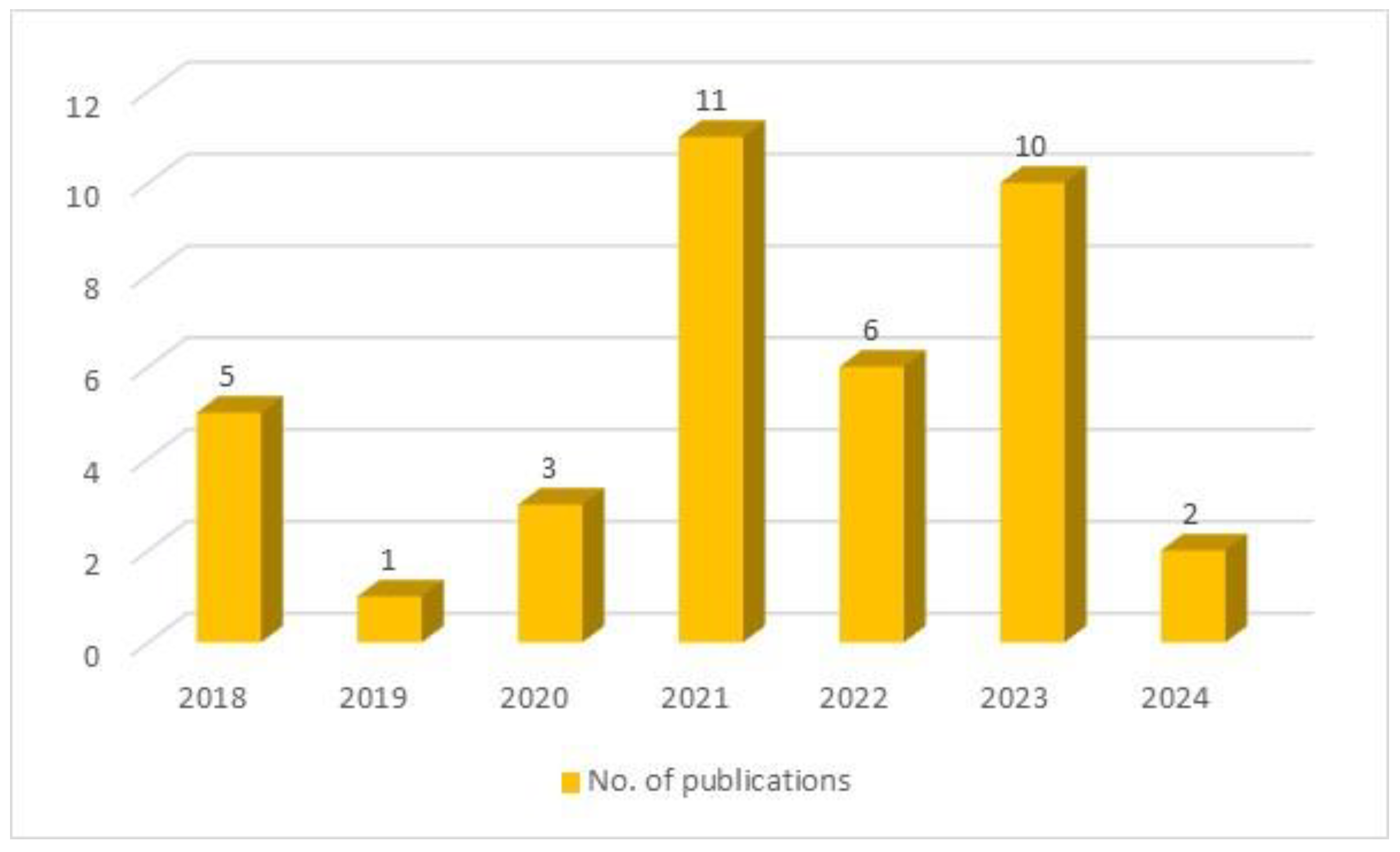
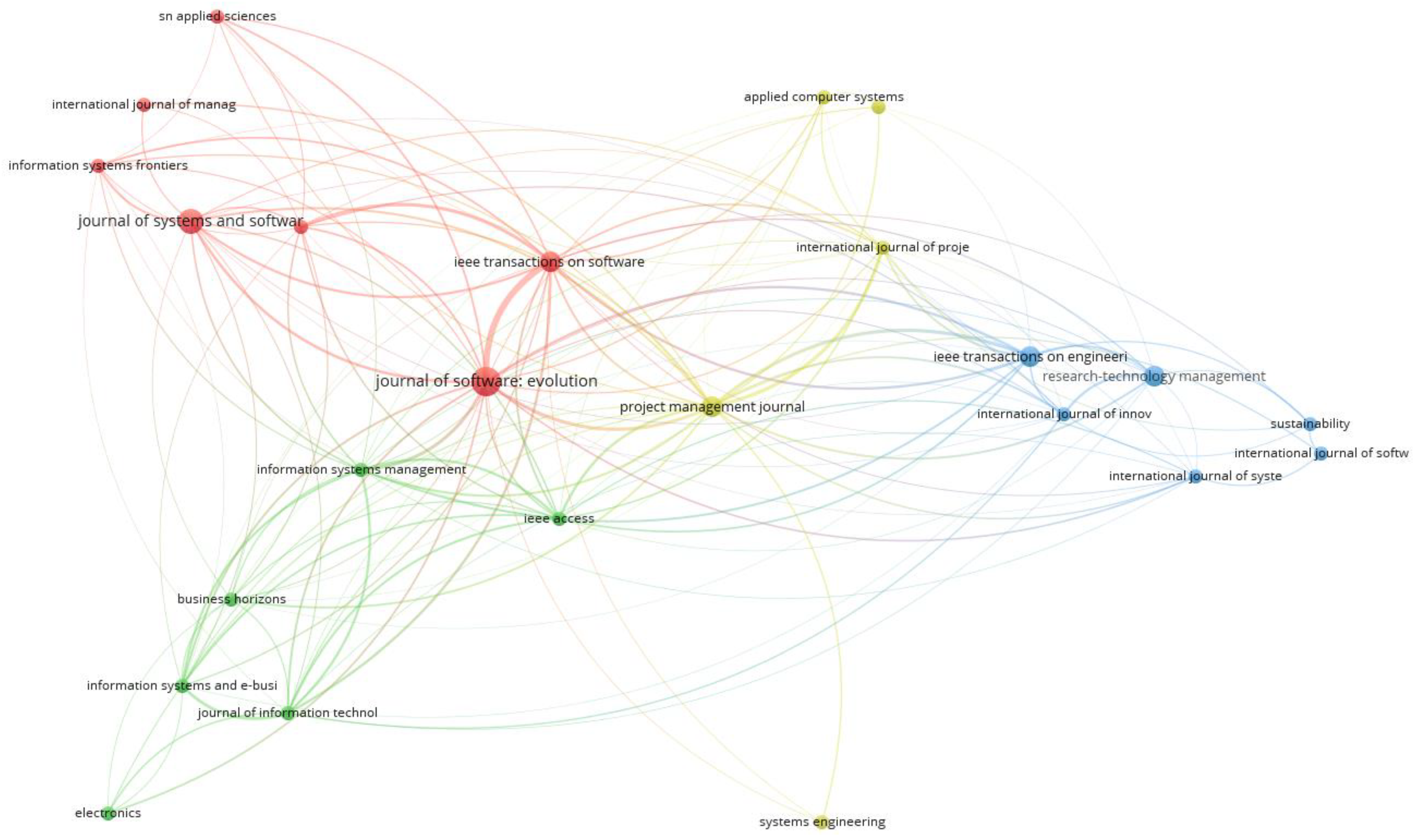
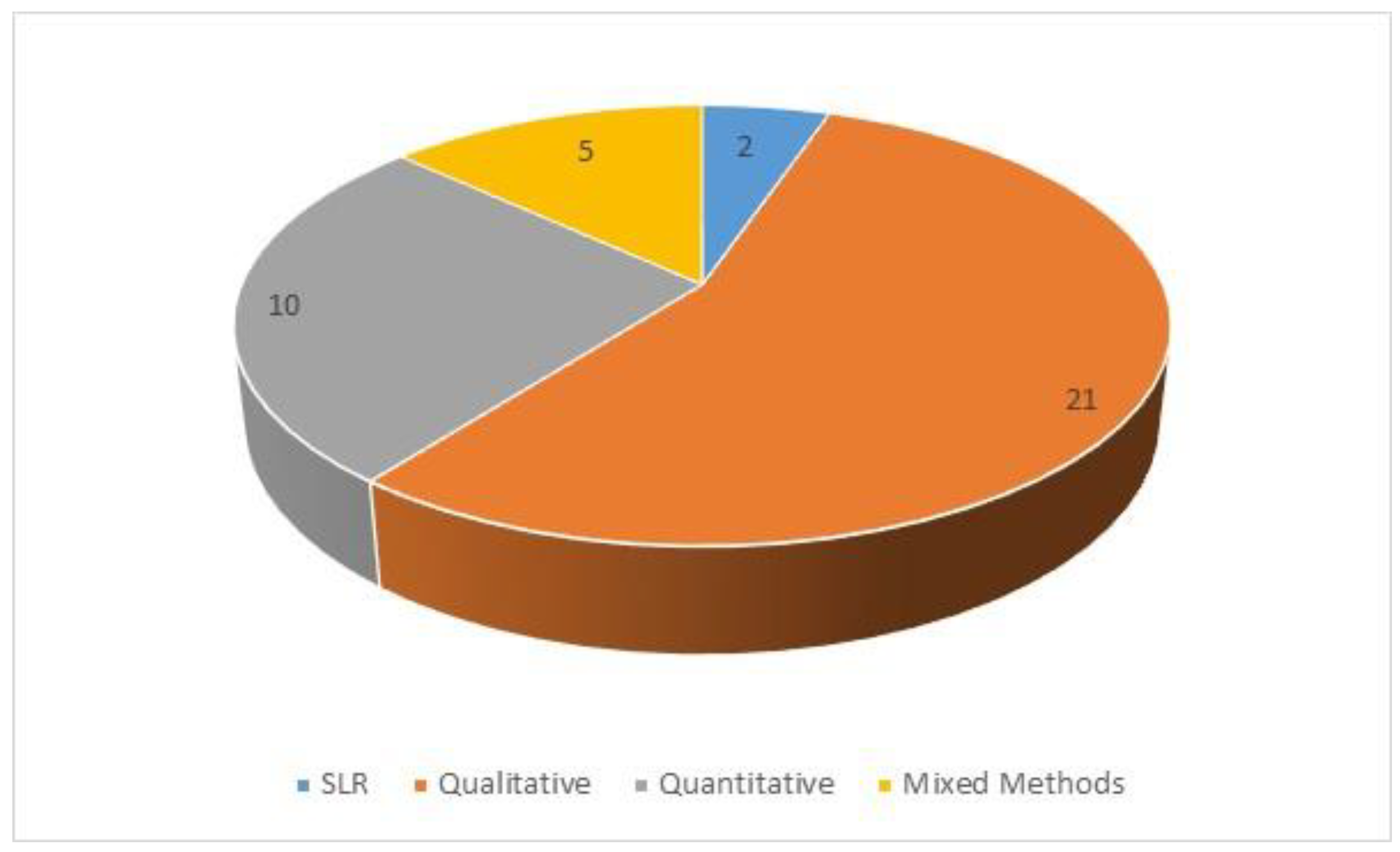
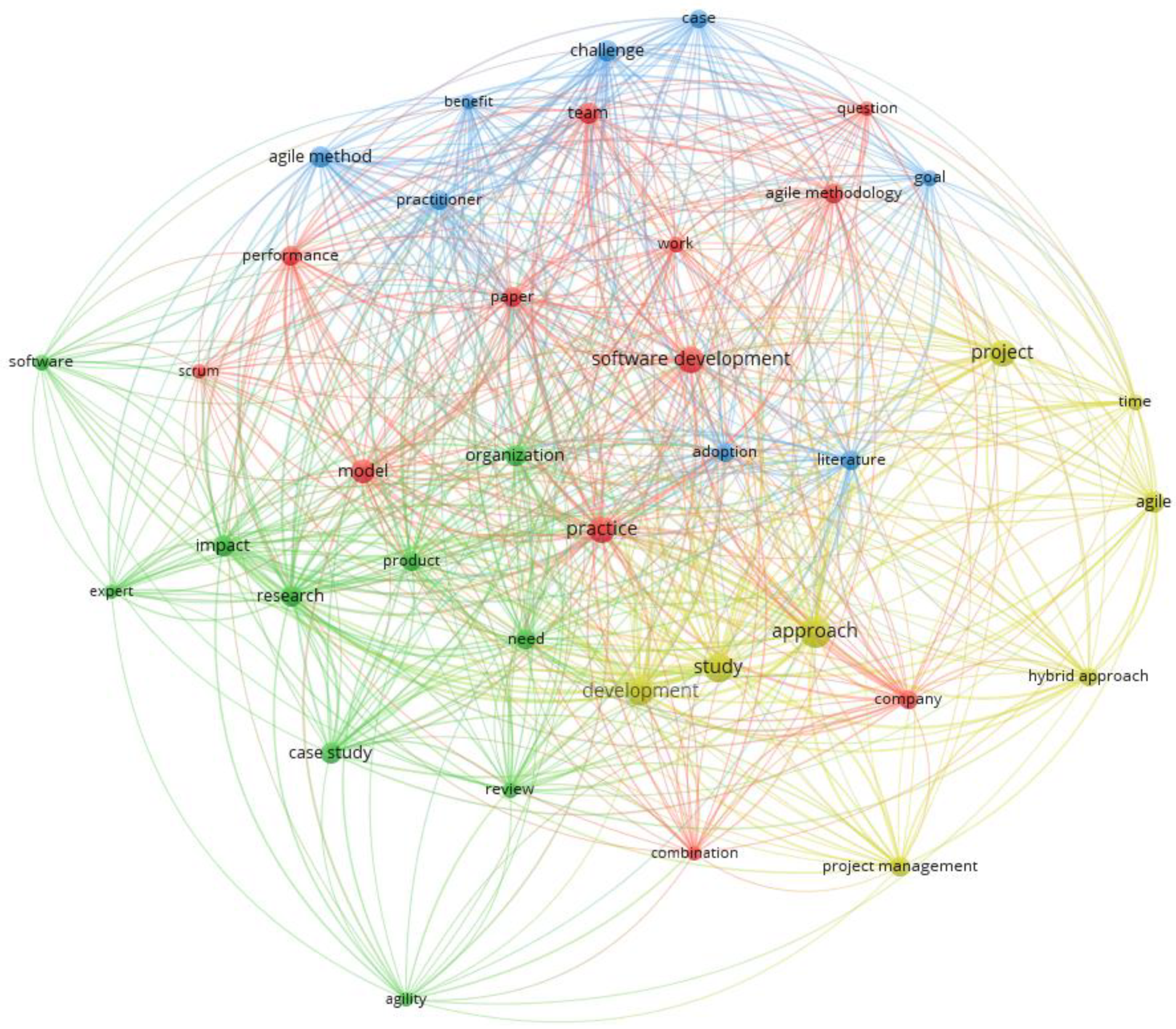
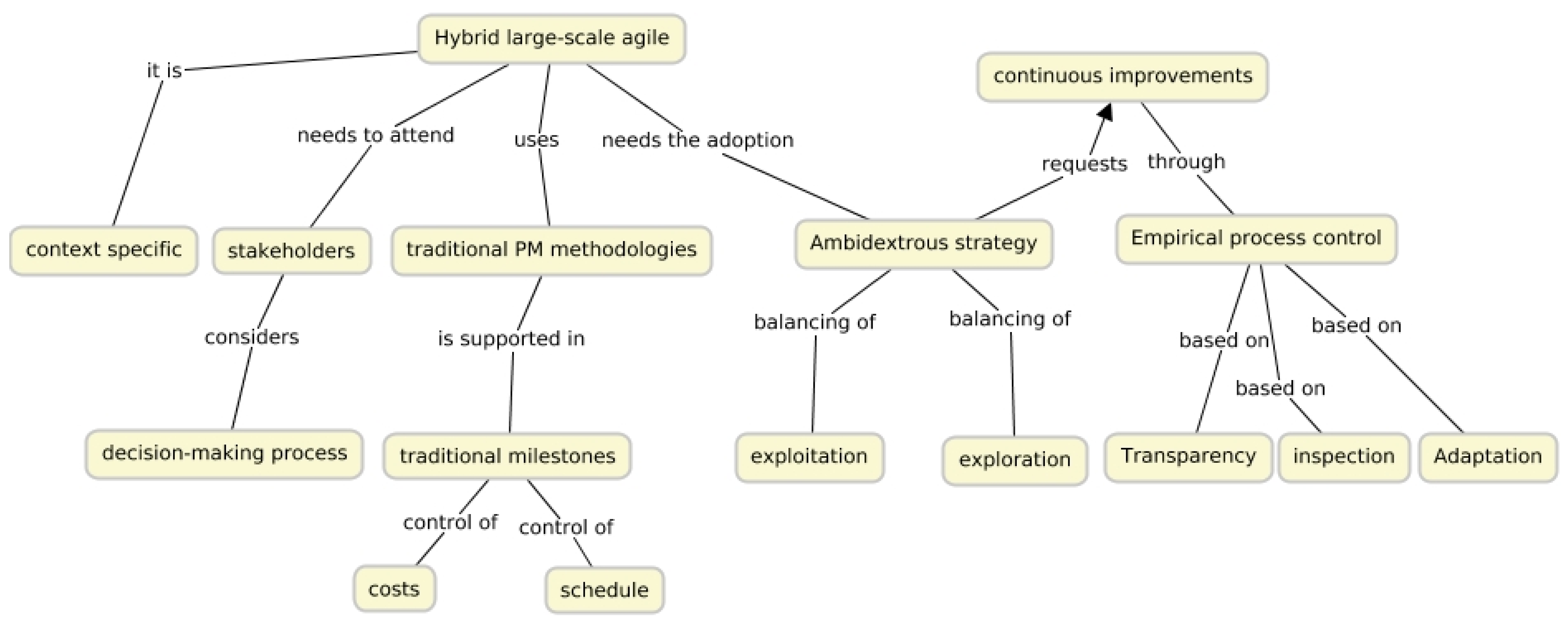
| Journal | N | % |
|---|---|---|
| Journal of Software: Evolution and Process | 4 | 10.53 |
| Journal of Systems and Software | 3 | 7.89 |
| Project Management Journal | 2 | 5.26 |
| IEEE Transactions on Software Engineering | 2 | 5.26 |
| IEEE Transactions on Engineering Management | 2 | 5.26 |
| Research Technology Management | 2 | 5.26 |
| Others | 23 | 60.53 |
| ID | Cluster | Frequent Key Terms | TNO | TNL |
|---|---|---|---|---|
| I | Methodology-focused cluster | agile methodology, combination, company, performance, practice, scrum, software development, team | 71 | 381 |
| II | Project-result-focused cluster | agility, case study, expert, impact, organization, product, software | 54 | 308 |
| III | Organization-focused cluster | adoption, agile method, benefit, challenge, practitioner | 43 | 250 |
| IV | Project-management-focused cluster | agile, approach, development, hybrid approach, project management | 56 | 212 |
Disclaimer/Publisher’s Note: The statements, opinions and data contained in all publications are solely those of the individual author(s) and contributor(s) and not of MDPI and/or the editor(s). MDPI and/or the editor(s) disclaim responsibility for any injury to people or property resulting from any ideas, methods, instructions or products referred to in the content. |
© 2024 by the authors. Licensee MDPI, Basel, Switzerland. This article is an open access article distributed under the terms and conditions of the Creative Commons Attribution (CC BY) license (https://creativecommons.org/licenses/by/4.0/).
Share and Cite
Almeida, F.; Bálint, B. Approaches for Hybrid Scaling of Agile in the IT Industry: A Systematic Literature Review and Research Agenda. Information 2024, 15, 592. https://doi.org/10.3390/info15100592
Almeida F, Bálint B. Approaches for Hybrid Scaling of Agile in the IT Industry: A Systematic Literature Review and Research Agenda. Information. 2024; 15(10):592. https://doi.org/10.3390/info15100592
Chicago/Turabian StyleAlmeida, Fernando, and Blaskovics Bálint. 2024. "Approaches for Hybrid Scaling of Agile in the IT Industry: A Systematic Literature Review and Research Agenda" Information 15, no. 10: 592. https://doi.org/10.3390/info15100592
APA StyleAlmeida, F., & Bálint, B. (2024). Approaches for Hybrid Scaling of Agile in the IT Industry: A Systematic Literature Review and Research Agenda. Information, 15(10), 592. https://doi.org/10.3390/info15100592









